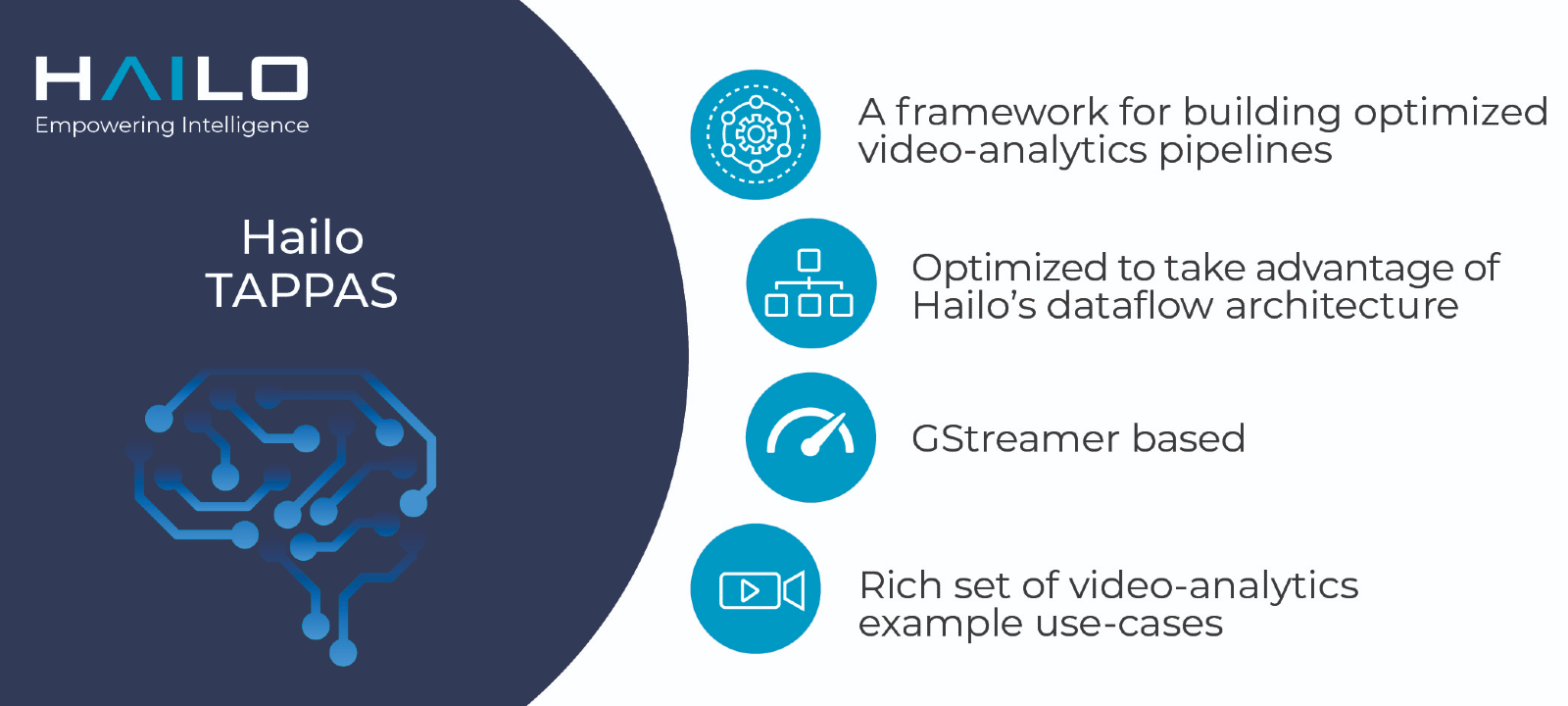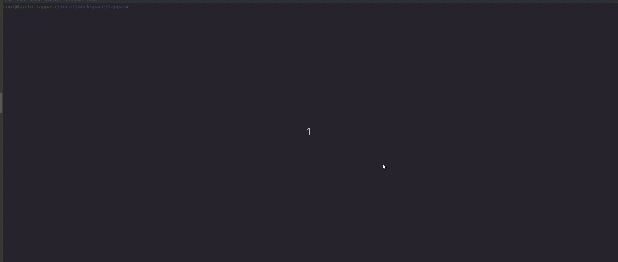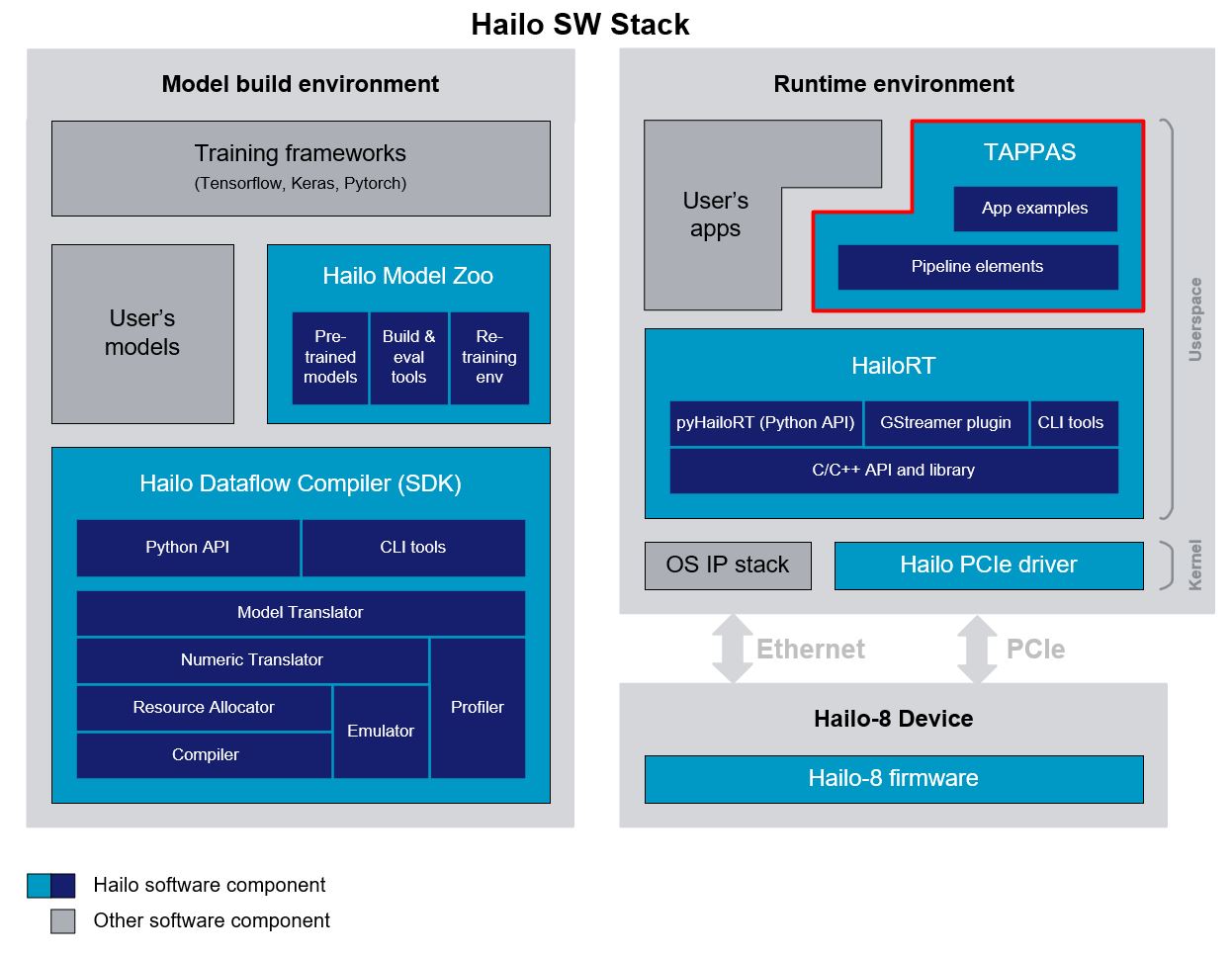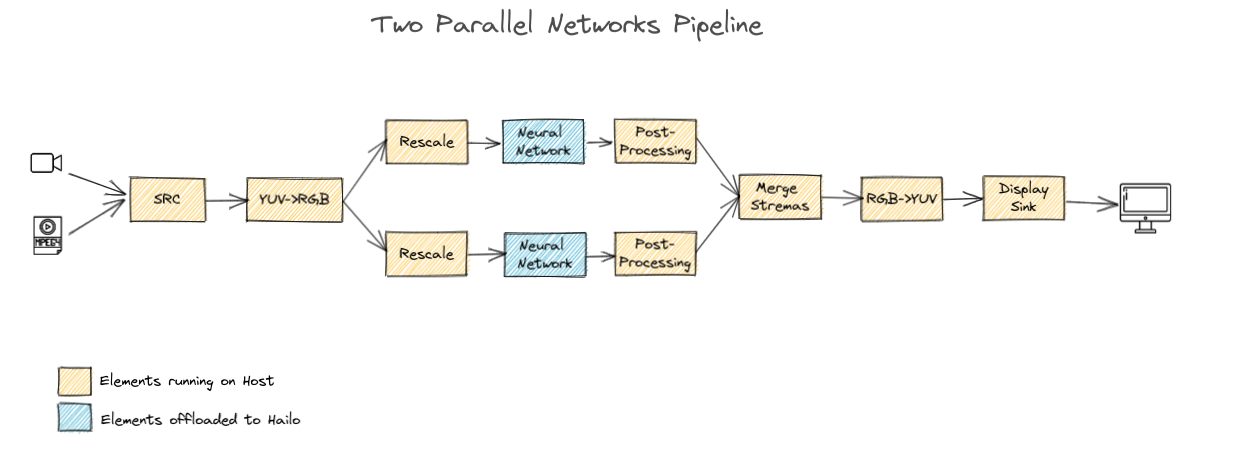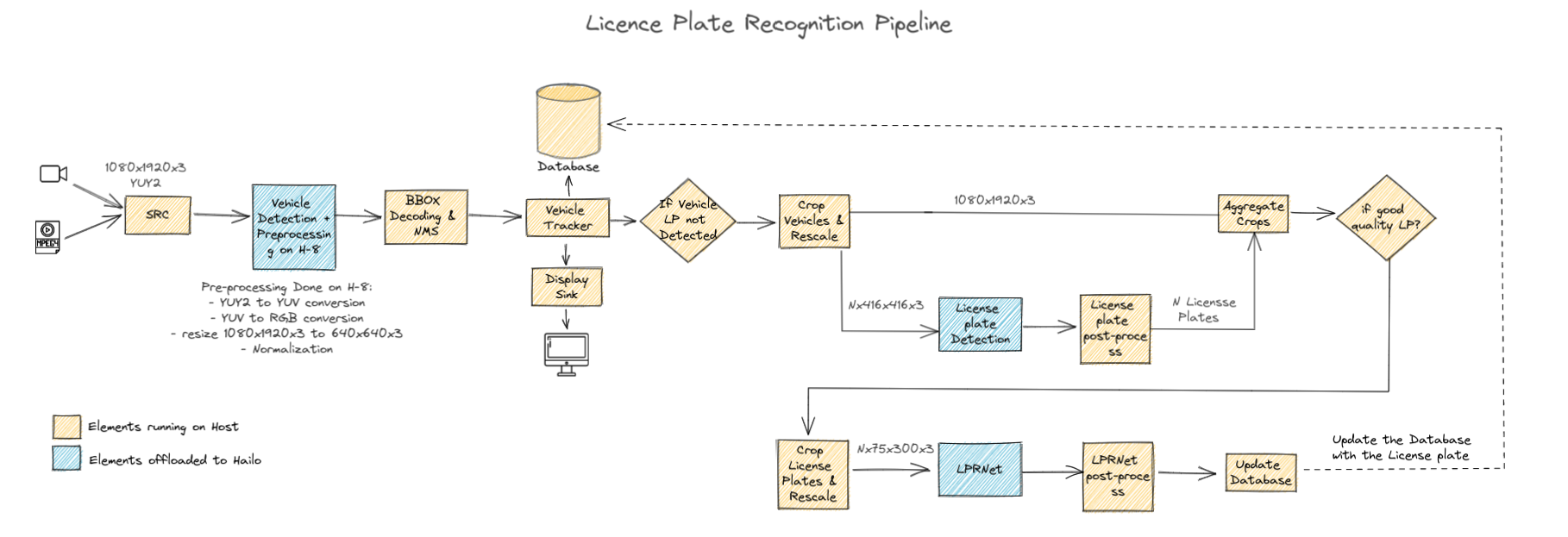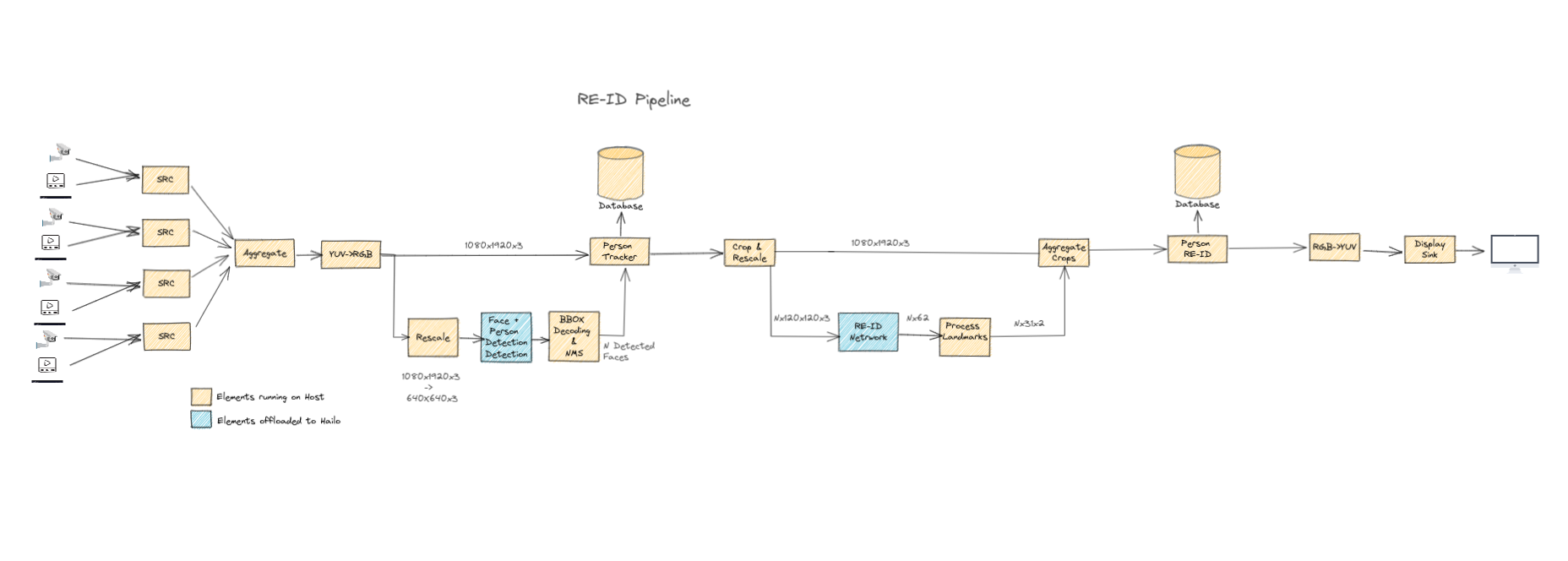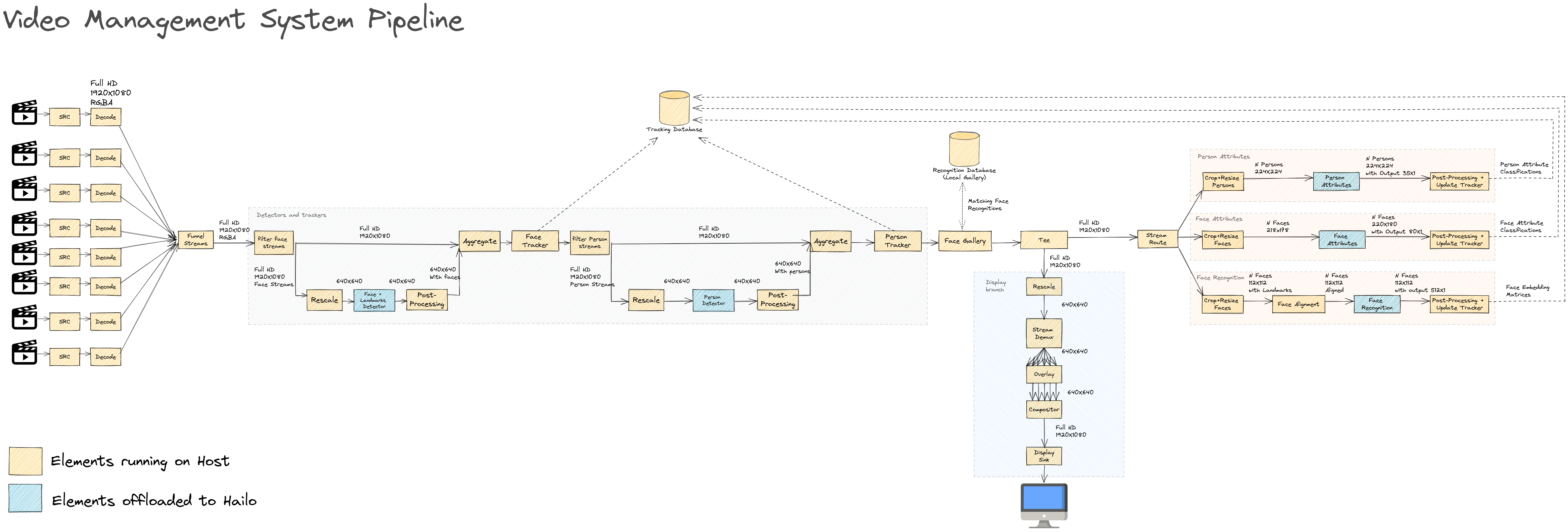TAPPAS is a framework for using video analytics to build optimized processing pipelines in systems with the Hailo-8 accelerator. Hailo-8 accelerates NN inference. TAPPAS optimizes the rest of the pipeline to take full advantage of Hailo's dataflow architecture.
The core of TAPPAS is a library of non-neural video-processing elements. These elements include:
- Hailo abstraction - elements to send/receive data from the Hailo accelerator.
- Glue-logic (e.g. format conversion YUV->RGB )
- Decision logic (e.g.rule-based filtering; branching; conditional invocation etc.)
- Data flow regulation elements (e.g. buffering; throttling; muxing/de-muxing)
- Functional elements (e.g. NMS, Tracking, Tiling, etc. )
TAPPAS comes packaged with a rich set of video analytics examples built on top of TAPPAS. These examples demonstrate common use-cases and showcase performance.
- Hailo-8 device
- HailoRT PCIe driver installed
- At least 6GB's of free disk space
Note
This version is compatible with HailoRT v4.12.0.
| Option | Instructions | Supported OS |
|---|---|---|
| Hailo SW Suite* | SW Suite Install guide | Ubuntu x86 20.04, Ubuntu x86 22.04 |
| Pre-built Docker image | Docker install guide | Ubuntu x86 20.04, Ubuntu x86 22.04, Ubuntu aarch64 20.04 (64-bit) |
| Manual install | Manual install guide | Ubuntu x86 20.04, Ubuntu x86 22.04, Ubuntu aarch64 20.04 |
| Yocto installation | Read more about Yocto installation | Yocto supported BSP's |
| Raspberry pi installation | Read more about Raspberry pi installation | Raspberry Pi OS, Ubuntu 20.04 |
* It is recommended to start your development journey by first installing the Hailo SW Suite
- Framework architecture and elements documentation
- Guide to writing your own C++ postprocess element
- Guide to writing your own Python postprocess element
- Debugging and profiling performance
- Cross compile - A guide for cross-compiling
TAPPAS comes with a rich set of pre-configured pipelines optimized for different common hosts.
Important
- All example applications utilize both the host (for non-neural tasks) and the Neural-Network Core (for neural-networks inference), therefore performance results are affected by the host.
- General application examples do not include any architecture-specific accelerator usage, and therefore will provide the easiest way to run an application, but with sub-optimal performance.
- Architecture-specific application examples (i.MX, Raspberry PI, etc.) use platform-specific hardware accelerators and are not compatible with different architectures.
Note
All i.MX example application are validated on i.MX8 and i.MX6 platforms and are compatible with the architectures.
Note
Running application examples requires a direct connection to a monitor.
Pipelines that run a single network. The diagram below shows the pipeline data-flow.
The following table details the currently available examples.
| General | i.MX8 | i.MX6 | Raspberry Pi 4 | x86 Hardware Accelerated | |
|---|---|---|---|---|---|
| Classification |  |
||||
| Object Detection |  |
 |
 |
 |
|
| Pose Estimation |  |
 |
 |
||
| Semantic Segmentation |  |
 |
 |
||
| Depth Estimation |  |
 |
 |
 |
|
| Face Detection |  |
 |
|||
| Facial landmark |  |
 |
|||
| Instance segmentation |  |
||||
| Classification with Python Postprocessing |  |
||||
| Object Detection Multiple Devices (Century) |  |
 |
Examples of basic pipelines running two networks. The parallel networks pipeline is an simple extension of the single network pipeline and is shown in the following diagram:
The cascaded (serial) flow shows two networks running in series. This example pipeline is of the popular configuration where the first network is a detector which finds some Region-of-Interest (ROI) in the input image and the second network processes the cropped ROI (a face-detection-and-landmarking use case of this pipeline is shown at the top of this guide). The pipeline is shown in the following diagram:
| General | i.MX8 | i.MX6 | Raspberry Pi 4 | x86 Hardware Accelerated | |
|---|---|---|---|---|---|
| Parallel - Object Det + Depth Estimation |  |
 |
|||
| Parallel - Object Det + Pose Estimation |  |
||||
| Cascaded - Face Detection & Landmarks |  |
 |
 |
||
| Cascaded - Person Det & Single Person Pose Estimation |  |
||||
| Cascaded - Face Detection & Recognition |  |
| General | i.MX8 | i.MX6 | Raspberry Pi 4 | x86 Hardware Accelerated | |
|---|---|---|---|---|---|
| Multi-stream Object Detection |  |
 |
|||
| Multi-stream Multi-Device Object Detection |  |
| General | i.MX8 | i.MX6 | Raspberry Pi 4 | x86 Hardware Accelerated | |
|---|---|---|---|---|---|
| HD Object Detection |  |
Our LPR reference application demonstrates the use of 3 networks, with a database. The pipeline demonstrates inference based decision making (Vehicle detection) for secondary inference tasks (License plate extraction). This allows multiple networks to cooperate in the pipeline for reactive behavior.
Our Multi-Person Multi-Camera Tracking reference application demonstrates person tracking across multiple streams using RE-ID tracking. The pipeline demonstrates another method for inference based decision making that also connects between different video streams.
Our VMS reference application demonstrates the use of 5 networks over multiple streams, and is a reference for video management system applications.
| General | i.MX8 | i.MX6 | Raspberry Pi 4 | x86 Hardware Accelerated | |
|---|---|---|---|---|---|
| LPR |  |
 |
|||
| RE-ID |  |
||||
| VMS |  |
v3.23.0 (December 2022)
- New Apps:
- Added x86_hw_accelerated example pipelines
that use Video Acceleration API (VA-API) over Intel processors that support
Quick Sync:
- Video Management System - a pipeline that demonstrates a VMS application which runs several streams and different tasks - Face Recognition, Face Attributes and Person Attributes. Currently this example pipeline is supported on Ubuntu 22.04 only
- Multi-stream detection
- Century
- Pose Estimation pipeline with two cascading networks - Person detection and single person pose estimation
- Face recognition
- Updated i.MX6 Object Detection App - New network, updated the pipeline to include i.MX6 hardware acceleration
- Added x86_hw_accelerated example pipelines
that use Video Acceleration API (VA-API) over Intel processors that support
Quick Sync:
- Added new models to Instance Segmentation Pipeline:
- yolact_regnetx_1.6gf
- yolact_regnetx_800mf (80 classes)
- Century app now uses a new network (yolov5m)
- Multi-Camera Multi-Person Tracking (RE-ID) - Improved pipeline performance and accuracy
- Added support for Ubuntu 22.04 (release-grade)
v3.22.0 (November 2022)
- New element hailoimportzmq - provides an entry point for importing metadata exported by hailoexportzmq (HailoObjects) into the pipeline
- Added Depth Estimation, Object Detection and Classification pipelines for i.MX6 Pipelines
- Changed the debugging tracers to use an internal tracing mechanism
v3.21.0 (October 2022)
- New Apps:
- Multi-stream detection that uses HailoRT Stream Multiplexer - Demonstrates the usage of HailoRT stream multiplexer (preview)
- New elements - hailoexportfile and hailoexportmq which provide an access point in the pipeline to export metadata (HailoObjects)
- Improved pipeline profiling by adding new tracers and replacing the GUI of gst-shark
- Ubuntu 22 is now supported (GStreamer 1.20, preview)
- Yocto Kirkstone is now supported (GStreamer 1.20)
v3.20.0 (August 2022)
- New Apps:
- Detection every X frames pipeline - Demonstrates the ability of skipping frames using a tracker
- Improvements to Multi-Camera Multi-Person Tracking (RE-ID) pipeline (released)
v3.19.1 (July 2022)
- New Apps:
- Multi-Camera Multi-Person Tracking (RE-ID) pipeline multi_person_multi_camera_tracking.sh (preview)
v3.19.0 (June 2022)
- New Apps:
- Added Cascading networks, Depth Estimation, Pose Estimation and Semantic Segmentation pipelines for i.MX Pipelines
- Added an option to control post-process parameters via a JSON configuration for the detection application
- Added support for Raspberry Pi Raspbian OS
- Native Application now uses TAPPAS post-process
- LPR (License Plate Recognition) pipeline is simplified to bash only
- New detection post-process - Nanodet
Note
Ubuntu 18.04 will be deprecated in TAPPAS future version
Note
Python 3.6 will be deprecated in TAPPAS future version
v3.18.0 (April 2022)
- New Apps:
- LPR (License Plate Recognition) pipeline and facial landmark pipeline for i.MX Pipelines
- Added the ability of compiling a specific TAPPAS target (post-processes, elements)
- Improved the performance of Raspberry Pi example applications
v3.17.0 (March 2022)
- New Apps:
- LPR (License Plate Recognition) pipeline for General Pipelines (preview)
- Detection & pose estimation app
- Detection (MobilenetSSD) - Multi scale tiling app
- Update infrastructure to use new HailoRT installation packages
- Code is now publicly available on Github
v3.16.0 (March 2022)
- New Apps:
- Hailo Century app - Demonstrates detection on one video file source over 6 different Hailo-8 devices
- Python app - A classification app using a post-process written in Python
- New Elements:
- Tracking element "HailoTracker" - Add tracking capabilities
- Python element "HailoPyFilter" - Enables to write post-processes using Python
- Yocto Hardknott is now supported
- Raspberry Pi 4 Ubuntu dedicated apps
- HailoCropper cropping bug fixes
- HailoCropper now accepts cropping method as a shared object (.so)
v3.14.1 (March 2022)
- Fix Yocto Gatesgarth compilation issue
- Added support for hosts without X-Video adapter
v3.15.0 (February 2022)
- New Apps:
- Detection and depth estimation - Networks switch app
- Detection (MobilenetSSD) - Single scale tilling app
v3.14.0 (January 2022)
- New Apps:
- Cascading apps - Face detection and then facial landmarking
- New Yocto layer - Meta-hailo-tappas
- Window enlargement is now supported
- Added the ability to run on multiple devices
- Improved latency on Multi-device RTSP app
v3.13.0 (November 2021)
- Context switch networks in multi-stream apps are now supported
- New Apps:
- Yolact - Instance segmentation
- FastDepth - Depth estimation
- Two networks in parallel on the same device - FastDepth + Mobilenet SSD
- Retinaface
- Control Element Integration - Displaying device stats inside a GStreamer pipeline (Power, Temperature)
- New Yocto recipes - Compiling our GStreamer plugins is now available as a Yocto recipe
- Added a C++ detection example (native C++ example for writing an app, without GStreamer)
v3.12.0 (October 2021)
- Detection app - MobilenetSSD added
- NVR multi-stream multi device app (detection and pose estimation)
- Facial Landmarks app
- Segmentation app
- Classification app
- Face detection app
- Hailomuxer gstreamer element
- Postprocess implementations for various networks
- GStreamer infrastructure improvements
- Added ARM architecture support and documentation
v3.11.0 (September 2021)
- GStreamer based initial release
- NVR multi-stream detection app
- Detection app
- Hailofilter gstreamer element
- Pose Estimation app
